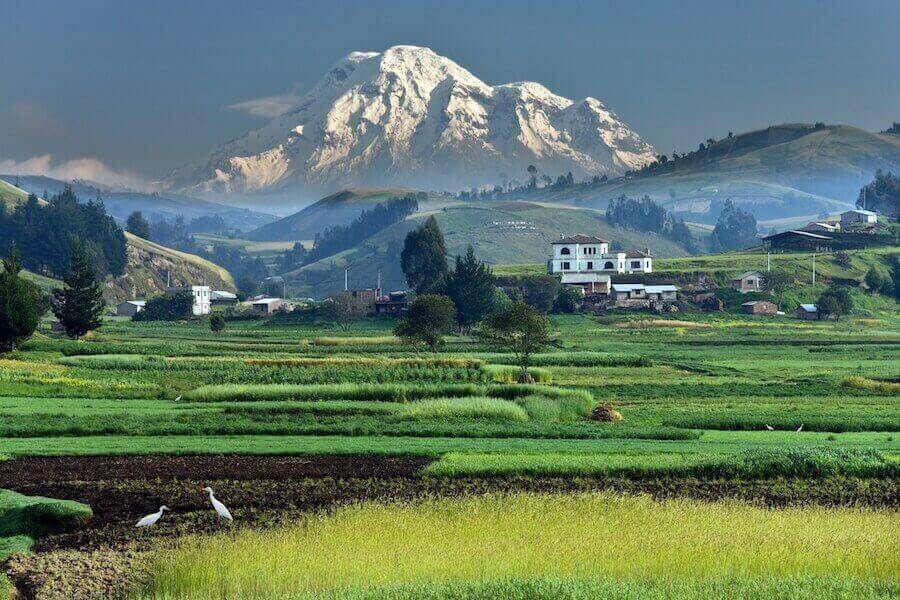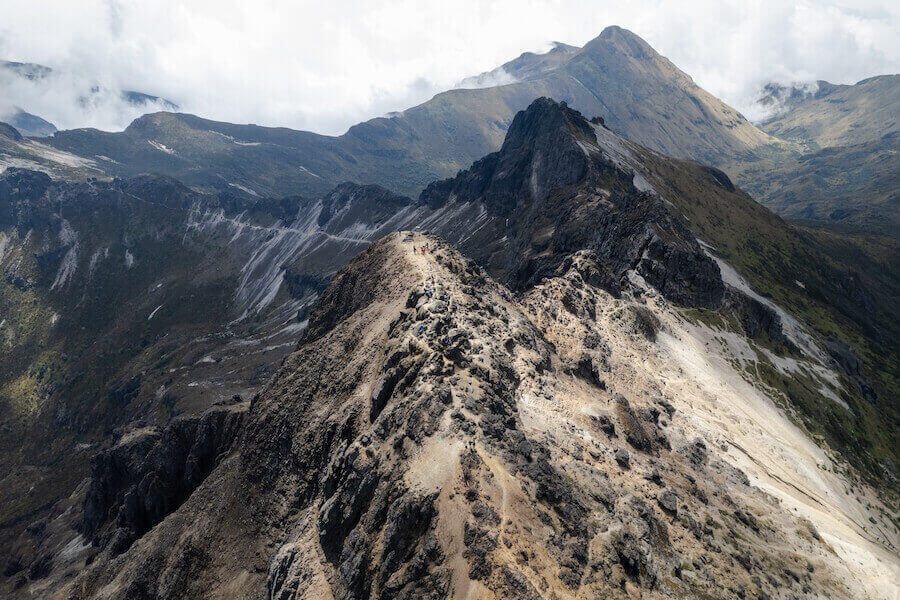Yes, it snows in Ecuador. The peaks of the Andes mountain range, which run along the country’s western border, are often covered in snow. In the northern part of Ecuador, snowfall is quite common during the winter months, with temperatures dropping to as low as -10°C at higher altitudes. In the south, snow is much less common but can still be found in some of the higher altitudes around Cuenca and Loja.
Ecuador Overview
Ecuador is a small country located in the northwestern part of South America. It borders Colombia to the north and Peru to the east and south. The Pacific Ocean lies to its west. The country sits right on the equator, giving it the name “Ecuador.”
Ecuador has a diverse landscape. Its terrain is extremely varied with high mountains, volcanoes, tropical rain forests, and beaches along the Pacific coast. The capital city is Quito, which is located in the Andes Mountains.
The official language is Spanish, and the currency is the US dollar. Ecuador is home to several indigenous groups, including the Kichwa, Shuar, and Quechua people. The country also has a vibrant Afro-Ecuadorian population descended from African slaves who were brought to Ecuador in colonial times.
Ecuador For Travel
Ecuador is a great destination for budget travelers. The cost of living is very affordable, especially compared to other countries in the region. You can find excellent hostels and hotels at reasonable prices, as well as delicious street food at small restaurants. Ecuador’s currency, the US dollar, makes it easier for visitors from overseas to budget.
While in Ecuador, you’ll want to explore the country’s wonderful national parks and wildlife reserves, which offer some of the most diverse flora and fauna in South America. The Galapagos Islands are also a must-see. The famously pristine archipelago is home to amazing species such as marine iguanas, albatrosses, and Darwin’s finches.
Ecuador is also home to a variety of cultures and traditions. From the colorful markets of Otavalo to the vibrant Afro-Ecuadorian festivals in Esmeraldas, there’s plenty to learn about the country and its people. And don’t forget about Ecuador’s colonial towns, charming architecture, and fascinating archaeological sites – a perfect addition to any itinerary.
Ecuador is a land of startling contrasts, where the Andes Mountains meet the Amazon rainforest. A paradise for nature lovers, it offers everything from snow-capped peaks to dense jungle, pristine beaches to active volcanoes. With its rich culture and welcoming people, Ecuador makes an ideal destination for any traveler.
Ecuador Climate
Ecuador is home to some of the most diverse climates in the world. Although Ecuador’s climate varies by region, it remains typically tropical year-round.
In coastal areas, temperatures typically remain hot and humid, with an average temperature hovering around 25°C (77°F). Along the coast, you can expect temperatures to remain comfortable throughout the year and rainfall is usually abundant.
In the Andean highlands, the climate is more temperate due to altitude. This region experiences cooler nights and days that are generally sunny with occasional rainfall. The average temperature in this region is around 12°C (54°F).
The Amazon region is damp and humid. Rainfall is abundant year-round, with temperatures between 17°C (63°F) and 30°C (86°F).
Overall, the Galapagos Islands are known for having the most consistent climate in Ecuador, with a warm and dry season from January to June and a cool and wet season from July to December. Average temperatures in the Galapagos range between 18°C (64°F) and 28°C (82°F).
No matter where you explore in Ecuador, you can expect an eclectic mix of climates! Be sure to bring layers so that you are prepared for anything.

Winter In Ecuador
Winter in Ecuador is a time of year when the weather is cool and the climate is dry. The winter season typically runs from June to August, although there can be some variation depending on the location within Ecuador. In general, colder weather and drier conditions are found in the highlands, while the coastal areas tend to be warmer and wetter during winter.
During the winter months, you can expect temperatures to range from 10-20 degrees Celsius (50-68 Fahrenheit) in the daytime and 7-15 degrees Celsius (45-59 Fahrenheit) at night. It is not uncommon for regions in the highlands to receive snowfall during these months, although it is rarer on the coast.
If you’re looking for outdoor activities during winter in Ecuador, there are plenty to choose from. Hiking along the many trails of Cotopaxi National Park is a popular choice, as the cooler temperatures make it more comfortable for longer treks. Paragliding and bird watching in Mindo Cloud Forest can also be fun activities.
When Does It Snow In Ecuador
Snowfall in Ecuador is extremely rare and occurs mostly in the extreme highlands of the country. The regions of Carchi, Imbabura, and Pichincha are the most likely places to experience snowfall in Ecuador. Snow has also been reported in Loja province in the southwest of Ecuador.
Most snowfall in Ecuador occurs in July and August when temperatures drop to about 0°C (32°F). During this period, snow can accumulate in the highlands up to 6 inches (15 centimeters). It is important to note that these areas are not easily accessible and require a 4×4 vehicle to reach.
Skiing is virtually non-existent in Ecuador since there aren’t any resorts that offer ski slopes. Those looking for a wintery experience in the country can find snow-covered mountains from June to October, which is the peak season for snowfall in Ecuador.
June Climate And Snow In Ecuador
June weather in Ecuador is usually characterized by warm temperatures with plentiful sunshine. The average temperature during the month of June ranges from 16-18 degrees Celsius (60-64 degrees Fahrenheit).
Generally, the months of June and July are the hottest months of the year in Ecuador. However, due to the diverse geography of this country, temperatures can vary greatly throughout the different regions.
In Ecuador’s highlands, such as Quito and Cuenca, June is generally dry with temperatures peaking in the low 70s (F). In the coastal lowland areas, it tends to be hotter and more humid with average temperatures of around 25-30 degrees Celsius (77-86 degrees Fahrenheit).
July Climate And Snow In Ecuador
July is a great time to visit Ecuador, as the country experiences warm temperatures and plenty of sunshine. The average temperature in July across Ecuador’s coastal regions is in the high 70s Fahrenheit (around 25 Celsius).
Inland areas are cooler, with temperatures ranging from the mid-60s Fahrenheit (19 Celsius) to the low 70s Fahrenheit (22 Celsius).
July is also a time for snowfall in Ecuador. The country experiences its most snowfall during July and August, when the highest peaks of the Andes mountains receive an average of 6-10 inches (15-25 cm) each month.
The mountain range that separates Colombia from Ecuador can reach up to 20,000 feet (6,096 meters) and is home to many volcanoes.
August Climate And Snow In Ecuador
August in Ecuador is usually a pleasant time of year, with mild temperatures and sunny days. The average temperature for August in the country ranges from 18°C (64°F) to 25°C (77°F).
In the northern part of the country, temperatures tend to be slightly cooler than those in the south, due to altitude. During the day, temperatures generally reach into the high twenties°C (around 78°F) and during the night, they dip down to around 18°C (64°F).
Rainfall is fairly consistent in August throughout Ecuador. Most areas receive between 10-20mm of rain per month, with some regions experiencing slightly more or less. It is important to note that the rain can vary greatly depending on where you are in the country, so be sure to check the weather forecast based on your location.
Where Does It Snow In Ecuador
One of the most well-known destinations for snow in Ecuador is Chimborazo, an inactive volcano located near the city of Riobamba and part of the Cordillera Occidental mountain range. Its summit stands at an elevation of 6,268 meters above sea level, making it the highest peak in Ecuador.
During certain times of the year, temperatures at Chimborazo’s summit can drop low enough to produce snowfall. Besides Chimborazo, there are a few other high altitudes mountains in Ecuador that experience occasional snowfall such as Altar and Cotopaxi, the latter being an active stratovolcano.
The town of Otavalo, located 2,850 meters above sea level, is also susceptible to snowfall on occasion. It lies in the Imbabura Province of northern Ecuador and is known for its traditional markets and culture.

Winter And Snow In Ecuador Cities
Winter In Quito
In the wintertime, Quito, the capital of Ecuador, experiences mild temperatures with an average temperature of around 14°C (57°F). The city is situated in a valley which keeps it cooler than its surrounding areas. Despite the lower temperatures and occasional drizzle, most days in Quito are sunny and clear. Due to its location in the mountains, Quito experiences a unique climate that makes it perfect for a winter vacation.
In addition to its mild temperatures, Quito offers plenty of activities and attractions that make it an ideal destination during the winter months. From exploring the city’s culture-filled plazas and museums to the surrounding nature, there is something for everyone to enjoy.
Winter In Cuenca, Ecuador
Cuenca, Ecuador is an incredibly beautiful city situated in the Andes Mountains of South America. During winter, temperatures tend to hover around 8-15°C (46-59°F), making it an ideal winter destination for those who prefer a mild climate. The days tend to remain sunny and bright, although a light wind often blows through the streets.
The city of Cuenca is known for its colonial architecture, cobblestone streets, and stunningly preserved churches and cathedrals. Visitors can take advantage of the many cultural attractions in this vibrant city, such as museums, historic sites, art galleries and artisan markets.
There are also plenty of outdoor activities to be enjoyed, such as hiking, kayaking and birdwatching. The winter season in Cuenca is also a great time to explore the city’s local cuisine. This city is known for its succulent dishes, such as llapingachos (potato patties) and locro (a potato and cheese soup).
Winter In Guayaquil
Guayaquil, Ecuador’s largest city, is located in the northern part of the country along the Pacific coast and experiences a tropical climate. Despite its location near the equator, Guayaquil experiences cold weather during winter months. The temperature during winter in Guayaquil can range from 13°C (55°F) to 27°C (80°F).
As winter approaches, the days become shorter and temperatures cool down. The city experiences more rain during this season, yet the sun usually still shines in the afternoon. Tourists can enjoy a mild climate with little risk of extreme cold throughout their stay.
Winter is a great time to visit Guayaquil as it offers a variety of activities and attractions, from local markets to historical sites. There are many things to do in the city, such as visiting the Guayaquil City Museum, exploring Parque Histórico, or taking a boat tour along the riverfront. For those who love nature, there are also plenty of beautiful green spaces to explore.